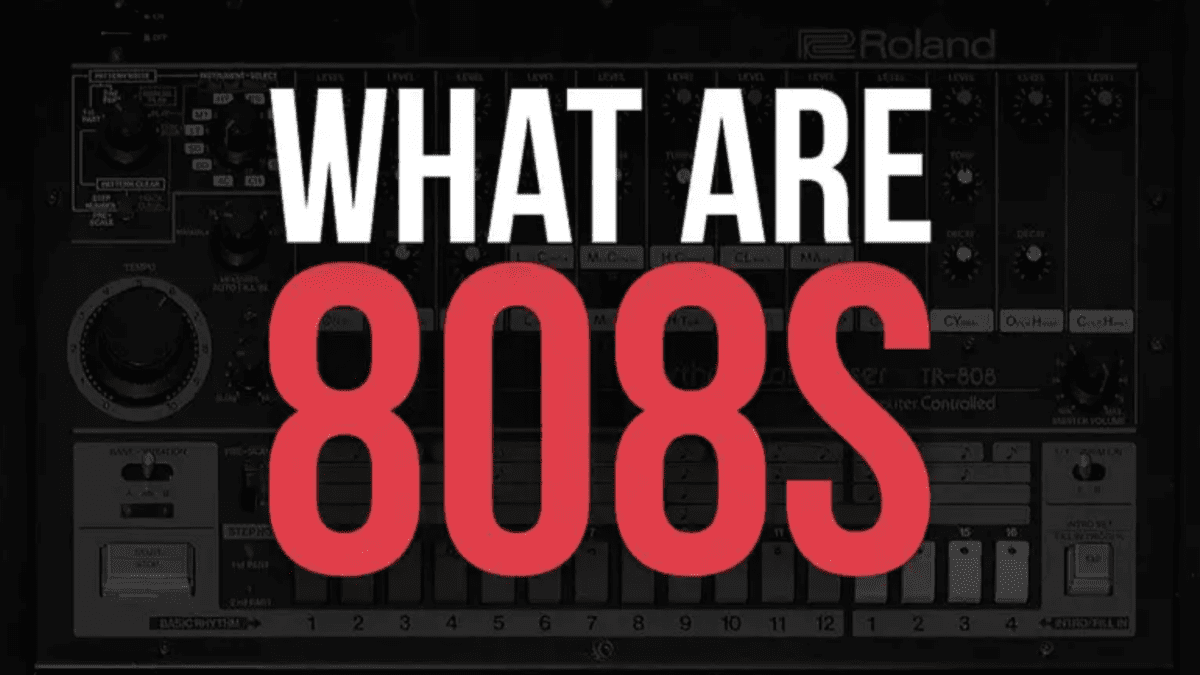So, you want to play a new musical instrument? Maybe you have always wanted to play music. Or maybe you have decided to learn a new skill? Whatever the case, choosing the ukulele and learning beginner ukulele chords is certainly a great decision for various reasons.
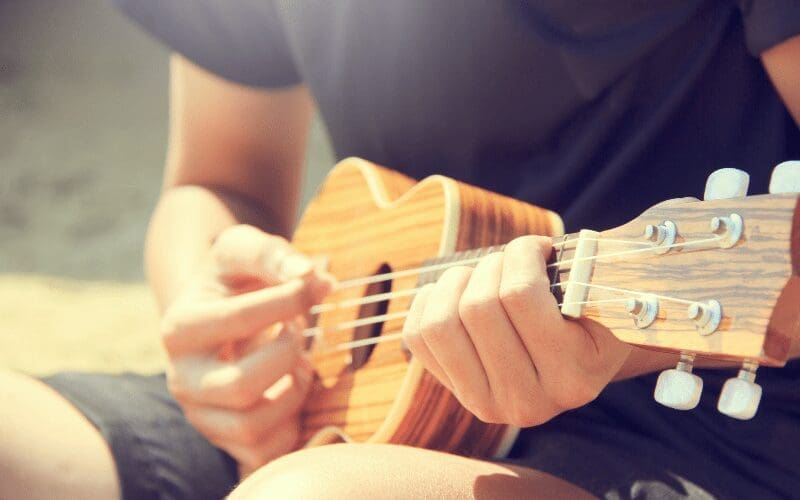
First of all, the ukulele sounds nice and is comparatively an easier musical instrument to play. Secondly, the ukulele is compact and lightweight, making it an extremely portable instrument.
Next time when you are on your way to that beach holiday, slide a ukulele in your bag and enjoy playing fun songs like Riptide and Somewhere Over The Rainbow with friends and family! You won’t regret it!
In this article, we will look at beginner ukulele chords and ukulele chord progressions. We will also touch on how to read ukulele chord chart, and chords for some famous 4-chord ukulele songs.
How To Tune A Ukulele

First things first, we have to tune our ukulele before we are able to play it.
Tuning means tightening or loosening the strings in a way where they all sound good together. Technically speaking, tuning is balancing the strings harmonically so the instrument sounds correct.
Starting from the top, here is the order of the strings for a standard ukulele tuning: G, C, E, A.
You can do this with any guitar or ukulele tuning app on your phone or online. These apps will display how much each string needs to be tightened or loosened in order for it to be G, C, E and A.
Some players tune the strings in a different order. Such as E, A, D, G or D, A, D, G. This is done for ‘artistic’ or ‘creative’ reasons.
The standard tuning, however, lets you play the majority of popular songs. So I would suggest just sticking to that. However, it is your ukulele, so you may as well go wild with tuning!
Right Hand or Left Hand?
The ukulele requires both of your hands to do different actions. If you are a right-handed person, you can think of your right hand being responsible for the percussive or rhythmic elements of the ukulele.
Your left hand provides the melodic content, the left-hand plays the harmony and melodies for a song. For a left-handed person, the right hand is used for melodic sounds while the left hand provides the rhythm.
How To Read A Chord Chart
Ukulele charts are simple and easy to read. They are extremely useful to convey the chord shape to fellow players or look up chords for a song in a book/online.
The chord chart contains 4 vertical lines. These lines represent the 4 strings from top to bottom. The ukulele charts are mostly displayed with standard tuning. This means the first vertical line is G. The second is C. The third is E and the fourth one is A.
The second thing you will notice on the chart is the horizontal lines. These lines represent the division of ‘Frets’. Frets are the spaces in between the horizontal lines, this is where you will put your fingers to change the melody.
Finally, there will be dots on various boxes with numbers in them. These dots represent the strings and frets which you are supposed to push while playing.
Beginner Ukulele Chords
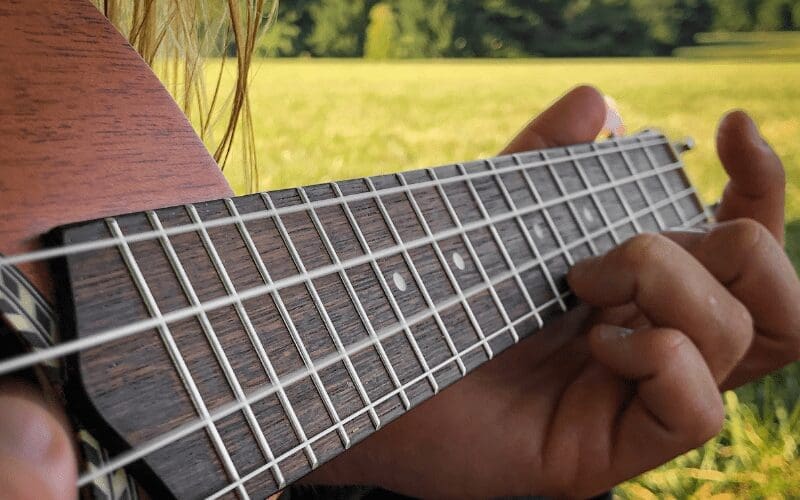
Now that we have established the functions of each hand and how to read the chord charts. Let’s get into basic ukulele chords so you can start playing some fun music!
Ukulele chords are constructed via the use of music theory and scales. If you would like to know more about the theory side of things, please have a look at our article Music Scale 101.
Major Ukulele Chords
Below are some beginner ukulele chords to try out! These chords have been used in countless popular songs. Some of these might be slightly challenging however, a little push might be very helpful for ukulele skills development.
Easy Ukulele Chords
C Major

C major chord is one of the easiest chords on the ukulele. All you need to do, is to put your ring finger on the third fret of the last string (A). Try playing all the 4 strings at the same time while the third fret of A string is pushed down.
D Major

D chord ukulele is slightly tricky but nothing too wild! You need to push the second fret on the G chord ukulele, C, and E strings (1, 2, 3) at the same time. You should use the middle, ring, and little finger for the D major chord.
E Major
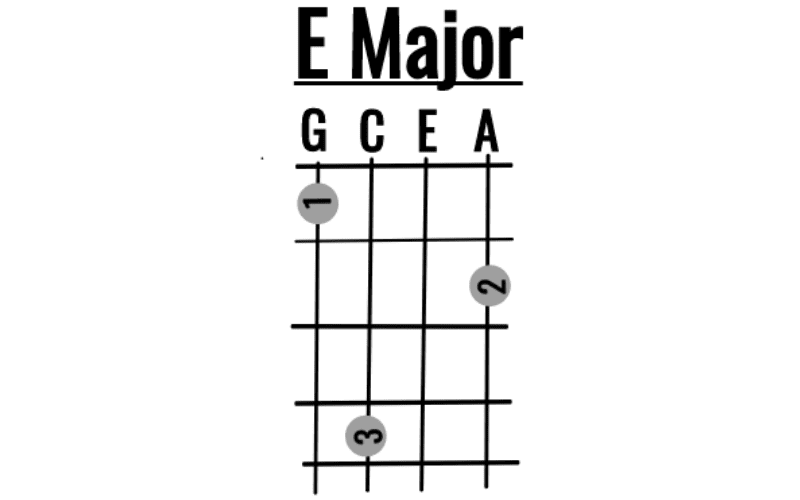
If you have managed to play C and D major chords, E major should be simple enough for you!
This chord requires 3 fingers, we will avoid the little finger for the E chord ukulele. The index finger will be pushing down the first fret on the G string.
The ring finger should be on the fourth fret of the C string and finally the middle finger on the second fret of the A string.
F Major

F major is another simple chord to play.
The middle finger should be on the second fret of the G string and the index finger on the first fret of the E string. It’s a common major chord and gets used a lot in ukulele based songs!
G Major

The G major chord is an important chord to know. You will notice this chord being used in many popular songs.
Generally, this is the first chord guitar players play on the ukulele, as the shape is very similar to the D major guitar chord.
To play the G major, you need an index finger on the second fret of the C string, A ring finger on the third fret of the E string, and middle finger on the second fret of the A string.
A Major

A major chord is very similar to an F major chord as it also only requires index and middle fingers.
The middle finger will be pushing down on the second fret of the G string while having the index finger on the first fret of the C string.
B Major
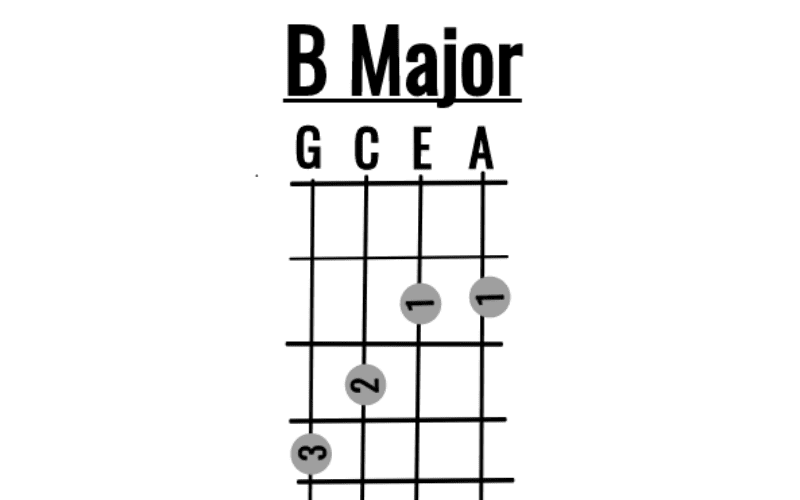
This is the final basic ukulele chords and possibly the most challenging one as well. It requires all 4 fingers on the fretboard of the ukulele.
The index finger will be pushing the second fret of the E and A strings at the same time. While having the middle finger on the third fret of the C string, and the ring finger on the fourth fret of the G string.
Minor Ukulele Chords
Let’s look at some minor chords. They will help you play even more songs and ultimately, help you have more fun!
There are generally 1 or 2 minor chords in ukulele based songs, so it is a good idea to know and practice them along the major chords.
C Minor

The first minor chord we will look at is C minor. This chord is similar to the D major chord as it uses 3 fingers and all of them push down on the second frets.
The middle finger on the C string, the ring finger on the E string and the little finger on the A string.
The good part is that you just need to focus on pushing the second fret of the bottom 3 strings.
D Minor

This chord is closely related to the F major as it uses the same shape with 1 additional fret.
The index finger should be on the first fret of the E string, the middle finger on the G string second fret and the ring finger on the C string second fret.
E Minor
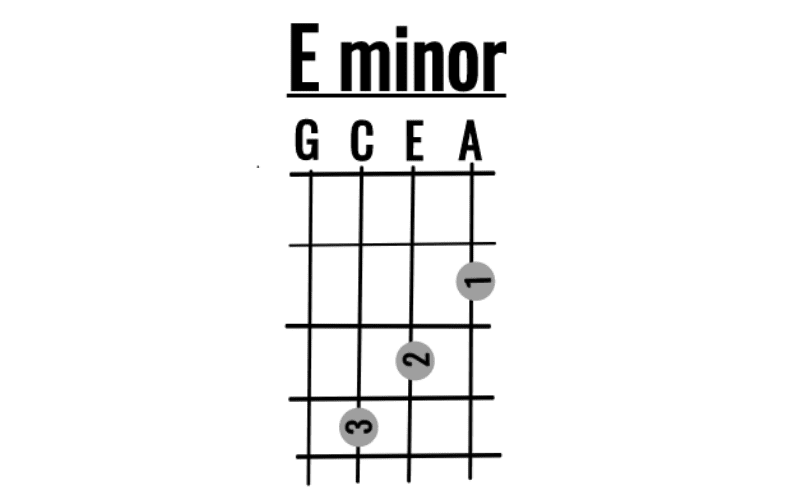
E minor chord requires 3 fingers as well.
The index finger on the second fret of the A string, the middle finger on the third fret of the E string, and finally, the ring finger on the fourth fret of the C string.
F Minor
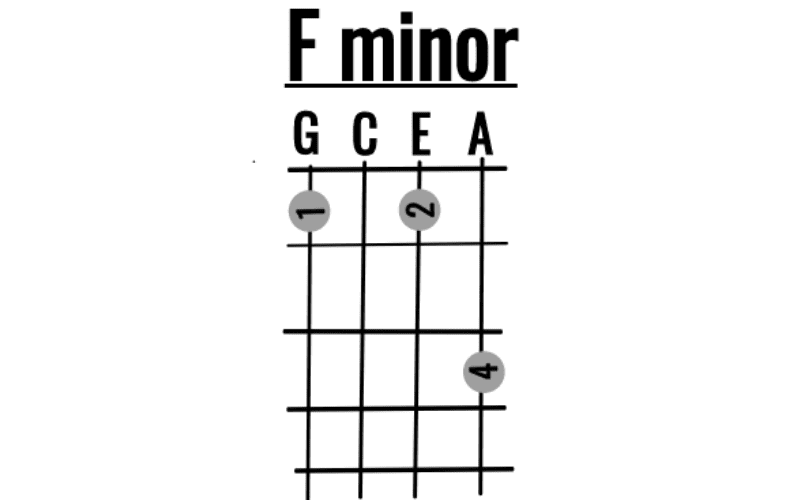
This chord is slightly tricky to play as it requires a bit of finger stretching. However, lucky for you, popular music doesn’t usually require F minor.
To play the F minor chord, the index finger needs to be on the first fret of the G string, so we leave the C string empty. The middle finger on the first fret of the E string and the little finger on the third fret of the A string.
G Minor
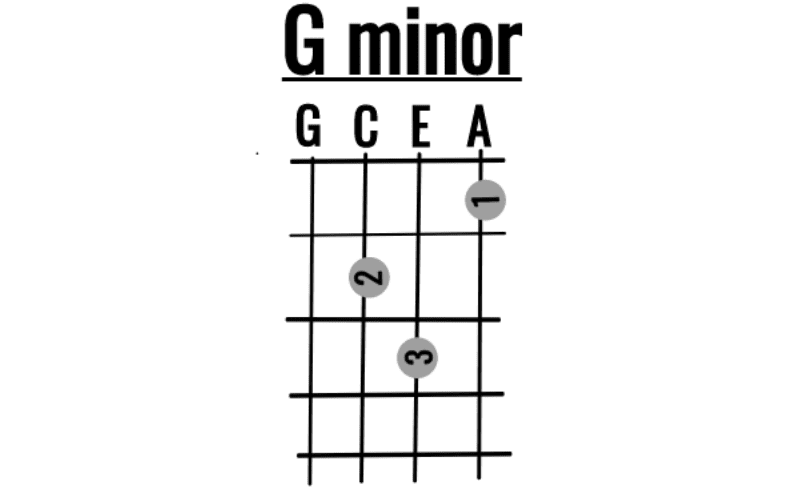
G minor chord requires 3 fingers, and this is one of the best good beginner ukulele chords to learn! This chord is another uncommon chord but you never know, you might like the sound and want to use it for your own music!
The index finger needs to be on the first fret of the A string. The middle finger is on the second fret of the C string, and the ring finger is on the third fret of the E string.
A Minor

A minor is a very important chord to know, especially in songs based on the ukulele. This chord is used in conjunction with C major, G major, and F major and has been used in countless songs.
It is also as easy as playing the C major chord. All we need to do is put the middle finger on the second fret of the G string. That is it!
B Minor

B minor is our last beginner ukulele chord. This chord requires only 2 fingers however, the index finger has to push 3 strings at the same time. It is not difficult but this shape requires a bit of practice.
To play, put your ring finger on the fourth fret of the G string while the index finger pushes down on the second fret of C, E and the A string at the same time.
Ukulele Rhythms

Now that we understand the chords and shapes for the melodic aspect of the ukulele, let’s get into the rhythmic side of things!
Imagine your right hand (left if you are left handed) is playing percussion or some kind of rhythm. In order to practice the above chords, try to strum all the 4 strings at all times.
Here are some rhythm examples to accompany your chords. These 3 rhythms will help you practice and move into more complicated rhythmic ideas!
- Down, Down, Down, Up, Down, Up
- Down, Down, Up, Up, Up, Down
- Down, Down, Up,
Common Four-Chord Progressions
Four-chord progressions are a cyclical way of playing a combination of chords over and over. The majority of popular songwriters use tried and tested chord progressions for writing their tunes. This is the reason why most of the radio hits sound quite similar.
Take a look at our Music Scale 101 article to help understand how these progressions are developed!
Here are some common chord progressions in the key of C major, which can help you play famous songs, such as the ones mentioned below! These chord progressions can also be transposed into any key by using music scale formulas.
- C Major, A minor, F major, G Major
- A minor, F Major, C Major, G Major
- C Major, G Major, A minor, F Major
- A minor, G Major, E minor, F major
Popular Ukulele Chords Songs

Riptide – Ukulele Chords
- A minor, G Major and C Major (Verse/Chorus)
- A minor, G Major, C Major and F major (Bridge)
Somewhere Over The Rainbow – Ukulele Chords
- C Major, E minor, F Major, C Major
- F Major, C Major, G Major, A minor, F Major (Verse/Chorus)
Happy Birthday – Ukulele Chords
- D Major, A Major, A Major, D Major
- D Major, G Major, D Major, A Major
Wherever You Will Go – Ukulele Chords
- C Major, E minor, A minor, F Major, G Major (Verse/Chorus)
Despacito – Ukulele Chords
- B minor, G Major, D Major, A Major (Verse/Chorus)
Coffin Dance MEME – Ukulele Chords
- A minor, G Major, F Major, G Major
Perfect (Ed Sheeran) – Ukulele Chords
- G Major, E minor, C Major, D Major
That’s All Folks!
So there you have it! Hopefully this article helped inspire you to pick up a ukulele and start practicing some tunes!
The next step will be to look for chords of your favorite songs, as they will be the ones that you enjoy playing the most! It is more than likely that the beginner ukulele chords of your favorite songs are one of the above 14 chords in this article. But if not, please share your recommendations in the comment section below!









